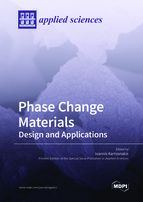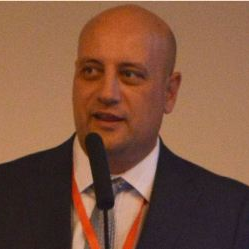Phase Change Materials: Design and Applications
A special issue of Applied Sciences (ISSN 2076-3417). This special issue belongs to the section "Energy Science and Technology".
Deadline for manuscript submissions: closed (30 May 2021) | Viewed by 31355
Special Issue Editor
Interests: nanotechnologies; corrosion science; electrochemistry; polymer science; chemistry; coatings; sol–gel method; carbon fibers/nanotubes
Special Issues, Collections and Topics in MDPI journals
Special Issue Information
Dear Colleagues,
In recent years, science and technology have revolutionized our way of life, improving well-being and comfort for all mankind. The discovery of new materials with unique features at macro- and nano-scales has played a significant part in this advancement. The possibility of producing materials able to perform different functions and of responding to external stimuli will undoubtedly be an extremely important research area for the foreseeable future.
Phase change materials (PCMs) are one of the key components for the development of advanced sustainable solutions in renewable energy and engineering systems. PCMs are enable to either store or release large amounts of energy, while their temperature is slightly changed or kept constant. PCMs have the ability to accumulate and store lots of energy. The activation of this high storage potential of PCMs is accomplished when their phase is changed.
This Special Issue aims to attract all researchers working in this research field, and will collect new findings and recent advances on the development, synthesis, structure–activity relationships, and future applications of PCMs. Research manuscripts and a limited number of review manuscripts are encouraged in the following areas:
- Energy/thermal storage
- Sustainable energy and engineering systems
- Batteries
- Structure–properties relationship
- Solar energy utilization
- Building/construction
- Environmental effects
- Recycling
Dr. Ioannis Kartsonakis
Guest Editor
Manuscript Submission Information
Manuscripts should be submitted online at www.mdpi.com by registering and logging in to this website. Once you are registered, click here to go to the submission form. Manuscripts can be submitted until the deadline. All submissions that pass pre-check are peer-reviewed. Accepted papers will be published continuously in the journal (as soon as accepted) and will be listed together on the special issue website. Research articles, review articles as well as short communications are invited. For planned papers, a title and short abstract (about 100 words) can be sent to the Editorial Office for announcement on this website.
Submitted manuscripts should not have been published previously, nor be under consideration for publication elsewhere (except conference proceedings papers). All manuscripts are thoroughly refereed through a single-blind peer-review process. A guide for authors and other relevant information for submission of manuscripts is available on the Instructions for Authors page. Applied Sciences is an international peer-reviewed open access semimonthly journal published by MDPI.
Please visit the Instructions for Authors page before submitting a manuscript. The Article Processing Charge (APC) for publication in this open access journal is 2400 CHF (Swiss Francs). Submitted papers should be well formatted and use good English. Authors may use MDPI's English editing service prior to publication or during author revisions.
Keywords
- Solid–liquid PCM
- Cooling
- Thermal storage
- Latent heat
- Transition temperature
- Thermal conductivity
- Heat transfer fluid
- Eutectics






